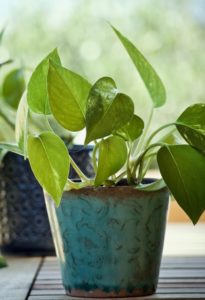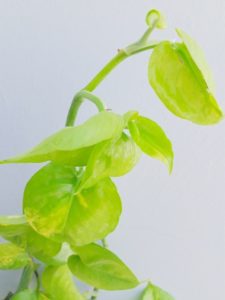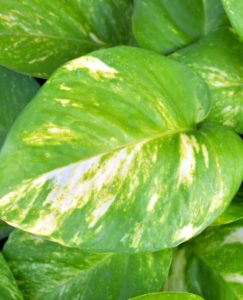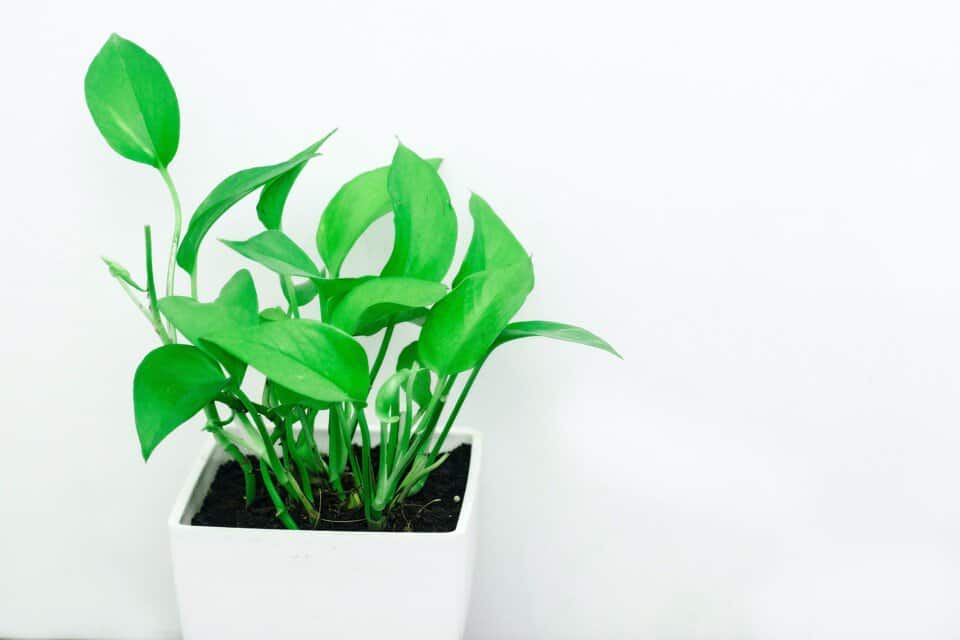Some links in the post are affiliate links and I get a commission from purchases made through some links found in the post.
The pothos plant is also known as devil’s ivy and is considered to be one of the best houseplants. They are very low-maintenance and do not ask much.
Those beauties will live even in the harshest conditions, however, in order to grow properly and produce beautiful foliage, the appropriate care must be taken.
Not everyone gives pothos fertilizer, however, if you do so, the plant will be thankful and will have enough food and nutrients to grow new and shining-green foliage.
There are several types of fertilizers that you can give to pothos, however, it is always recommended to avoid chemical ones and is recommended to give them organic food that you can easily make at home.
The perfect pothos fertilizer must have an equal amount of all those elements for example an NPK of; 10:10:10, 15:15:15, or 20:20:20 ratios.
One of the major parts of the care is providing enough food. In most cases, the soil in the pot can not provide needed nutrients and minerals and our little green friends need some help from us, and that’s what the fertilizers are for.
However, you need to know the correct ratios, when to give, and how to give your pothos fertilizer. In this article, we will discuss all these details and share the pothos care tips, that will help you to make your plant thrive.
When Should I Fertilize my Pothos?
 Pothos plants require frequent feeding since they grow quickly. You should fertilize your pothos plant in the spring and summer.
Pothos plants require frequent feeding since they grow quickly. You should fertilize your pothos plant in the spring and summer.
This is the growing season and therefore, the plant uses much more nutrients and food. So, the additional help can be provided by giving pothos fertilizer.
Fertilizer is most effective when applied to plants during their active growth cycle. The best time of year to fertilize most plants is in the spring.
There are many different types of fertilizers, and each of them has a unique schedule and time. However, if you are using liquid fertilizer, it can be easy to manage the schedule and control when to give it.
Generally, a fertilizer for a pothos should be given in every two to four weeks. And remember, this must only be done during the growing season.
Nevertheless, it’s crucial to keep in mind that using too little fertilizer is better in comparison to using too much. If too much is given, then your pothos plant may suffer harm or perhaps die if you overfertilize it.
Follow the instructions on the fertilizer box exactly before applying it to the plant and be careful how much you use.
Typically, the fertilizers have to be diluted at half strength before giving to the pothos plant. By diluting your fertilizer, you can prevent a concentration of nutrients from “burning” your pothos.
What Type of Fertilizer Should you Give your Pothos?
Pothos do not consume a lot of food. Those plants lose their vitality and become more susceptible to pests and diseases when they don’t receive enough nutrients.
If the plant lacks nutrients and is not healthy, then it is much easier for pests to get drawn to it.
You can use An all-purpose fertilizer on your pothos plant. Make sure that it comes with balanced nitrogen phosphorus, and potassium ratio, also known as the NPK ratio.
Those are the elements that generally have a significant role in plant growth.
The perfect pothos fertilizer must have an equal amount of all those elements. Meaning that it must come in 10:10:10, 15:15:15, or 20:20:20 ratios.
This kind of fertilizer is simple to locate in your neighborhood garden shop or home improvement retailer. Because it supplies the nutrients plants require in the proper amounts, and is regarded as the finest pothos fertilizer.
You may still use your pothos fertilizer even if the NPK ratio is unbalanced. You might need to modify your fertilizer usage, though. For instance, you’ll need to apply less fertilizer if it has a greater nitrogen ratio.
Fortunately, the pothos plant is adaptable and tenacious, so even if you apply the fertilizer
incorrectly, it will probably recover. Just make sure to thoroughly read and adhere to the directions on the fertilizer’s container.
Your pothos plant needs nitrogen more than any other nutrient. It is a crucial ingredient for photosynthesis. Additionally, nitrogen is important for supporting healthy leaf and stem development.
Nitrogen should be a part of any fertilizer you put on your pothos plant.
In order to determine whether your pothos is receiving adequate nitrogen, check for symptoms like yellowing leaves or reduced development. Both of these point to a deficiency in nitrogen for your plant.
How Much Fertilizer Should you Give your Pothos?
In general, for a good dilution, you can mix liquid fertilizer measured at 1 teaspoon with 2 cups of water.
Pay special attention to the directions on your fertilizer’s box because this quantity may change based on many factors, including the strength of particular fertilizer.
Pour the fertilizer mixture over the soil surrounding your pothos plant after combining it with the water.
To ensure that the roots can absorb all of those nutrients, make sure to thoroughly moisten them. Pouring the solution gently will give it time to reach the roots and permeate into the soil.
Our 3 Recommended Fertilizers for a Pothos
1) Neptune’s Harvest Fish & Seaweed Fertilizer 2-3-1
This particular fertilizer comes with a rating of 4.7 on Amazon. The fertilizer is not only beneficial for the pothos plant but also very affordable.
The Neptune 2-3-1 fertilizer, which has been approved by the Organic Materials Review Institute for its thorough component selection, is a proven method to make sure your Pothos plants stay healthy and colorful.
Fish and seaweed are among the ingredients of Neptune’s Harvest fertilizer, which helps plants develop their own natural sugars. Because of this influence, Pothos plants grow stronger, greener, and lusher.
The mixture can be used on both indoor and outdoor plants. You can apply it with the watering can, dripline, or a sprayer, once it has been blended.
Your bottle will provide roughly 32 ounces of water for indoor plants. The combination for outside yields 16 ounces. This pothos fertilizer is recommended to be used during the growing season every 1 to 2 weeks.
2) Miracle-Gro Indoor Plant Food Spikes
Those Plant Food Spikes make applying fertilizer simple, convenient, and mess-free.
Depending on the season, these Miracle-Gro products include a slow-release composition that can supply nutrients for one to two months.
You’ll discover that the high phosphorus to nitrogen nutrition ratio promotes root development and supports nitrogen’s efficiency, ensuring that your Pothos has lush, green leaves.
However, in comparison to other pothos fertilizers, this one tends to be a little more expensive. Wondering how to use the food spikes?
Make a little hole between the stem and the rim of the soil. The fertilizer spike should be pushed into the ground until it is completely buried.
3) Miracle-Gro Indoor Plant Food (liquid) 1:1:1
The Miracle-Gro Indoor Plant Food Liquid mixture is one of the best options if you want a quick and simple alternative to mixing, stirring, or digging in the ground to fertilize your indoor plants.
The 1-1-1 ratio is ideal for the health of your Pothos plant and won’t overfertilize it (if applied correctly).
There is a good balance in this formula, therefore diluting it is not necessary. But given that Pothos plants are more susceptible to fertilizer burn than other houseplants, it is recommended to dilute to half strength.
To mix with water, you can use four pumps per quart of water. Apply as part of your regular watering schedule for your pothos plant.
Medium plants require two pumps of fertilizer, compared to one for small pots. This type of fertilizer can be given every week.
How to Make a Homemade Fertilizer for your Pothos
A pothos fertilizer that is well-balanced and includes all of the vital elements that pothos plants require to grow is ideal. You can make organic fertilizers at home easily
There are several different choices of what can be used as pothos fertilizer, and you can choose the one that you prefer the most.
Homemade fertilizers are often made from the leftover food that can be found at any home and can be pretty beneficial.
Such fertilizers are, for example, green tea, Compost, and aquarium water combined in equal parts. Your plant will receive a healthy balance of nitrogen, phosphorus, potassium, and calcium from this mixture.
You might be unsure of whether natural or homemade fertilizer is best for your pothos plant because there are so many alternatives available.
In short, it doesn’t really matter because all of the ones mentioned above can contribute to the success of your pothos. Generally, all of them are safe to use even if you overdose, and there is no risk of root burn.
Remember well, that it can be challenging to combine homemade fertilizer with an exact pothos fertilizer ratio, so be sure to complete your study on the precise nutrients your pothos plant need.
Finding the ideal fertilizer ratio for your plant may require some trial and error, however, it will eventually work out and you will manage to create fine pothos fertilizer.
Is Banana Water Good for Pothos?
 The plant hack involving banana peel fertilizer tea has probably already been shared on houseplant social media pages numerous times.
The plant hack involving banana peel fertilizer tea has probably already been shared on houseplant social media pages numerous times.
Bananas are high in potassium. In fact, it’s the perk of consuming these fruits that is most frequently mentioned.
One of the three major macronutrients that pothos plants need in considerable proportions is potassium. Bananas are therefore thought to be equally healthy for plants as they are for people.
Due to its role in promoting leaf growth, nitrogen is the nutrient for houseplants that receives the most attention. However, potassium is just as significant.
It not only encourages healthy, robust roots but also affects water absorption and makes indoor plants more resilient to one or two missed waterings.
However, Water made from banana peels cannot be regarded as a full fertilizer. In fact, given its poor nutritional value, it is debatable whether it really qualifies as fertilizer.
Your plants will have nutritional deficiencies if you just feed them with this combination.
Is Rice Water Good for Pothos?
Rice water may be used to water pothos plants Because it has enough fertilizer and minerals that are essential for the plant and are often found in NPK fertilizers.
Additionally, rice water promotes healthy bacteria. Rice water may be sprayed in any way and, when fermented, can even fight off pests.
You can get the rice water by washing the grains, or by straining out the excess water during the rice boiling process.
The starches in rice water also give the plant the essential carbohydrates needed by the plants. It can store in its cell membrane which is especially needed for energy.
Are Eggshells Good for Pothos?
Since eggshells are rich in calcium. Typically, calcium may build up in the soil and make it difficult for your plant to absorb other crucial minerals.
However, the eggshells will give the plant needed calcium in a proper way and can be advantageous for pothos plants. They also assist in enhancing soil aeration, drainage, and leaf strength.
Many gardeners use eggshells as pothos fertilizer since it is a quick and affordable way to supply calcium to the soil. Additionally, calcium strengthens the plant’s leaves and aids in the plant’s uptake of other nutrients.
Eggshells assist the soil’s pH level to rise as they break down, and they also enhance drainage and aeration. It works best when grounded into a powder in a food processor or coffee grinder.
After being crushed up, you can either include them into your potting mix or add them to the soil surrounding your plant.
Eggshells can also be steeped in water for 24 hours to produce tea. When the steeping procedure is over, you can pour the water into the pot where your beloved pothos plant is.
When replanting or repotting your pothos plant, you may simply fill the pot with eggshells before adding the fresh soil. This will enhance the pot’s drainage and aeration.
It’s crucial to avoid using too many eggshells because doing so might cause the soil to become too alkaline.
Adding around one eggshell per gallon of soil is a good general rule of thumb. To lessen their impact, you may also put them in your compost pile.
To ensure that eggshells won’t turn the soil too alkaline for your pothos plant, test the soil beforehand, just like you would with coffee grounds.
Additionally, be careful to completely remove any egg residue left on the shells before use.
Are Coffee Grounds Good for Pothos?
 Pothos plants can benefit from coffee grounds, but they shouldn’t be the only source of fertilizer. This is due to the high nitrogen content of coffee, which, if used in excess, can actually burn your plant’s roots.
Pothos plants can benefit from coffee grounds, but they shouldn’t be the only source of fertilizer. This is due to the high nitrogen content of coffee, which, if used in excess, can actually burn your plant’s roots.
Coffee grinds are a common substitute for conventional fertilizers these days.
If you’re attempting to make up for the nitrogen deficiency in your pothos plant, using the leftover coffee grinds could be a smart idea. Carefully add a few coffee grounds to the water or soil.
To start with, you may utilize your coffee grounds to boost your soil’s pH level. The quantity of acid in the soil decreases as a result of soil oxidation, which causes it to become basic.
It’s beneficial occasionally to add something acidic to your soil to reduce the pH level. When it comes to this, coffee grinds are useful.
There are several various methods you may use to fertilize your pothos plant using coffee grinds.
One method is to immediately add discarded coffee grinds to the soil surrounding your plant. Additionally, you might make a cup of coffee and use the remaining liquid to water your plant.
Making a fertilizer tea with coffee grounds is another technique to utilize for pothos. You must soak used coffee grinds in water for 24 hours to do this.
Before adding coffee grounds, try testing your soil’s pH to make sure it won’t be too acidic for your pothos plant.
For pothos plants, a pH level of six to seven is advised. Keep adding the coffee grinds if your soil is more acidic than that and take a closer look.
Are Fertilizer Spikes Good for Pothos?
Fertilizer spikes are a fantastic choice if you want a fertilizer that releases nutrients gradually. Therefore, the fertilizer spikes can be a good option for pothos.
When you water the plants, these compressed sticks that have been driven into the soil gradually release nutrients.
However, keep a watch on the NPK values because many contain nitrogen levels that are too high for Pothos plants.
One of the pothos fertilizers that we recommended above is spikes, and eventually, it can benefit your pothos by helping in growth.
When Should you not Fertilize your Pothos?
You should not fertilize the pothos plant in the late autumn and winter months.
This is the time when the pothos plant is dormant. It does not stop the growth and keeps living regularly, however, much slower than in the growing season.
As a result, needs much fewer nutrients which is absolutely enough in the soil. Therefore, make sure to not give any kind of fertilizer to your pothos plant in winter.
Final Thoughts
 There are many different types of fertilizers that you can give to the pothos plants and it is up to you to decide which one will be the most beneficial for your plant.
There are many different types of fertilizers that you can give to the pothos plants and it is up to you to decide which one will be the most beneficial for your plant.
Several things to consider when giving the pothos fertilizer is to not give it too much and dilute it in half. Additionally, it is recommended to give your pothos fertilizer that is liquid.
Additionally, you can also consider some alternatives discussed above, organic, natural, and handmade fertilizers can be much more beneficial for your beloved plants than chemical ones.





